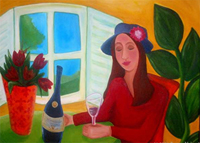Complementary colors
Complementary colors are pairs of colors that are of “opposite” hue in some color model. The exact hue “ complementary” to a given hue depends on the model in question, and perceptually uniform, additive, and subtractive color models, for example, have differing complements for any given color.
Color theory
In color theory, two colors are called complementary if, when mixed in the proper proportion, they produce a neutral color (grey, white, or black). In roughly-perceptual color models, the neutral colors (white, greys, and black) lie along a central axis. For example, in the HSV color space, complementary colors (as defined in HSV) lie opposite each other on any horizontal cross-section.
In most discussions of complementary color, only fully saturated, bright colors are considered. However, under the formal definition, brightness and saturation are also factors. Thus, in the CIE 1931 color space, a color of a particular “dominant” wavelength can be mixed with a particular amount of the “complementary” wavelength to produce a neutral color (grey or white).
In the RGB color model (and derived models such as HSV), primary colors and secondary colors are paired in this way:




Art and design
Because of the limited range of colors that was available throughout most of the history of art, many artists still use a traditional set of complementary pairs, including:
The complement of each primary color (red, blue, or yellow) is roughly the color made by mixing the other two in a subtractive system:
The use of complementary colors is an important aspect of aesthetically pleasing art and graphic design. This also extends to other fields such as contrasting colors in logos and retail display. When placed next to each other, complements make each other appear brighter. On an artistic color wheel, complementary colors are placed opposite one another. Although these artistic complements may not be precise complements under the scientific definition, most artistic color wheels are laid out roughly like the HSV color wheel discussed above.







